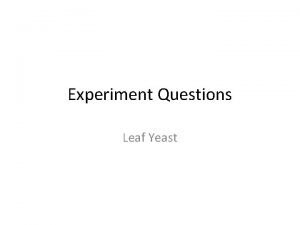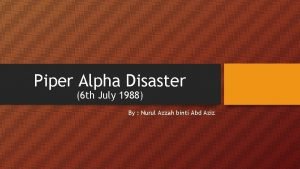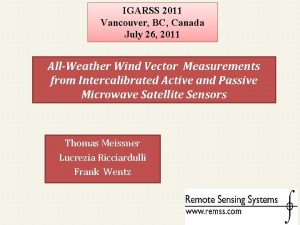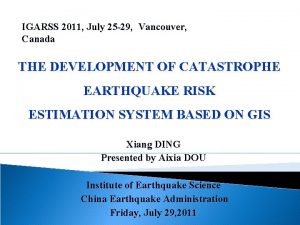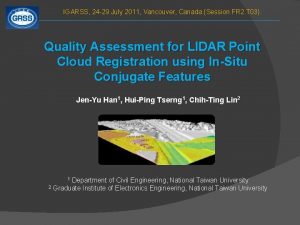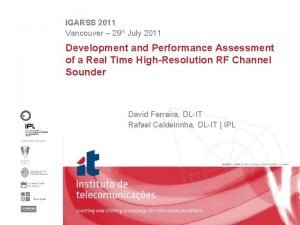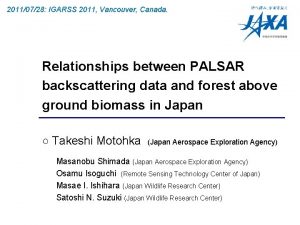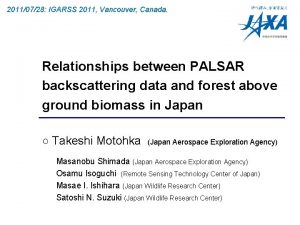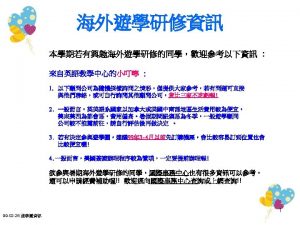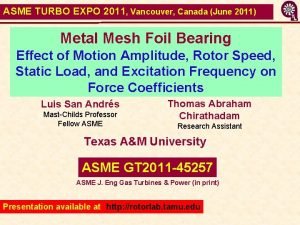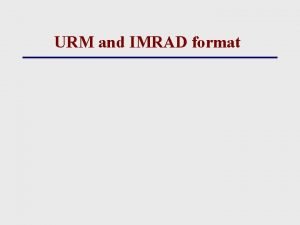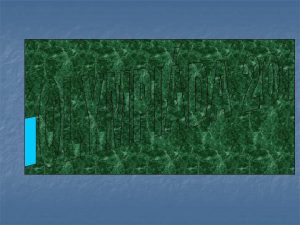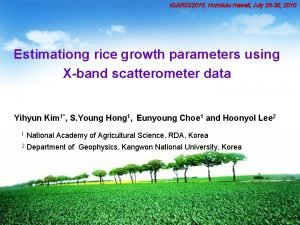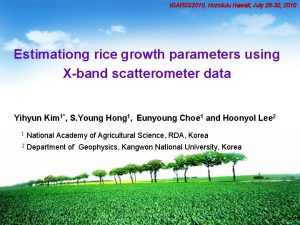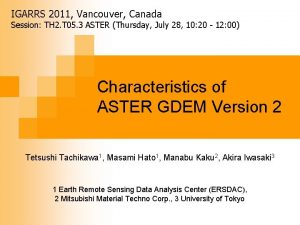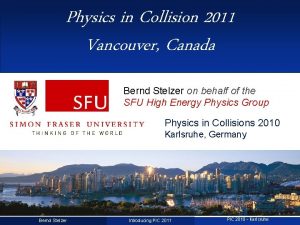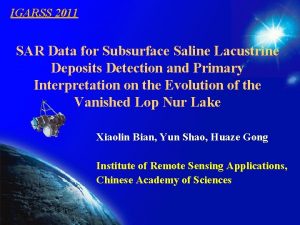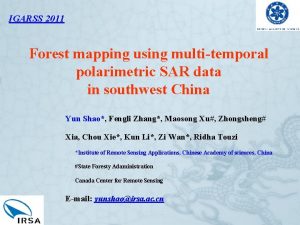IGARSS 2011 July 24 29 2011 Vancouver Canada




![Candidates for wetland boundary classification 1. HH-VV phase difference: [1] K. O. Pope, et Candidates for wetland boundary classification 1. HH-VV phase difference: [1] K. O. Pope, et](https://slidetodoc.com/presentation_image_h/1f28af7af4ec8a7b5c98753d90bc9421/image-5.jpg)

![Candidates for wetland boundary classification 3. LL-RR correlation coefficient: [Kimura 2004] K. Kimura, et Candidates for wetland boundary classification 3. LL-RR correlation coefficient: [Kimura 2004] K. Kimura, et](https://slidetodoc.com/presentation_image_h/1f28af7af4ec8a7b5c98753d90bc9421/image-7.jpg)



























![Polarimetric FDTD analysis 3. Correlation coefficient in LR basis Amplitude Phase [deg. ] 0. Polarimetric FDTD analysis 3. Correlation coefficient in LR basis Amplitude Phase [deg. ] 0.](https://slidetodoc.com/presentation_image_h/1f28af7af4ec8a7b5c98753d90bc9421/image-35.jpg)
![Polarimetric FDTD analysis 3. Correlation coefficient in LR basis Amplitude Phase [deg. ] 0. Polarimetric FDTD analysis 3. Correlation coefficient in LR basis Amplitude Phase [deg. ] 0.](https://slidetodoc.com/presentation_image_h/1f28af7af4ec8a7b5c98753d90bc9421/image-36.jpg)





- Slides: 41

IGARSS 2011, July 24 -29, 2011, Vancouver, Canada Polarimetric Scattering Feature Estimation For Accurate Wetland Boundary Classification Ryoichi SATO*, Yoshio YAMAGUCHI, and Hiroyoshi YAMADA Niigata University, Japan

Introduction Progress of Global warming - Unusual weather (Climate change) - Natural disasters (Flooding, Water shortage) Monitoring of “Natural resources” (Forests, wetlands, etc. ) Winter Lake “Sakata” and surrounding wetland Copyright © 2001 -2004 Niigata City. All rights reserved.

Introduction “Pol. SAR image analysis” is a useful tool for continuous wetland monitoring Pi-SAR http: //www. das. co. jp/new_html/service/05. html Airborne Pol. SAR ALOS/PALSAR http: //www. alos-restec. jp/aboutalos 1. html Satellite Pol. SAR Summer So far, Copyright © 2001 -2004 Niigata City. All rights reserved. Accurate and “complex” wetland classification method

Objective ``Simple’’ water area classification marker for water-emergent boundary 1. Pol. SAR image analysis around wetland area Validity of some polarimetric indices as useful markers for water-emergent boundary classification 2. FDTD polarimetric scattering analysis for a simple water-emergent boundary model Verification of the generating mechanism of specific polarimetric scattering feature at the boundary
![Candidates for wetland boundary classification 1 HHVV phase difference 1 K O Pope et Candidates for wetland boundary classification 1. HH-VV phase difference: [1] K. O. Pope, et](https://slidetodoc.com/presentation_image_h/1f28af7af4ec8a7b5c98753d90bc9421/image-5.jpg)
Candidates for wetland boundary classification 1. HH-VV phase difference: [1] K. O. Pope, et al. , ``Detecting seasonal flooding cycles in marches of the yucatan peninsula with sar-c polarimetric radar imagery, ’’ Remote Sensing Environ. , vol. 59, no. 2 pp. 157 -166, Feb. 1997. Reed Ground Water Looks like Dihedral reflector

Candidates for wetland boundary classification Surface scattering Reed Ground Double-bounce scattering Volume scattering Water Looks like Dihedral reflector TRUE Water area 2. Double-bounce scattering: Ps Pd Pv Pc [5] A. Freeman and S. L. Durden, ``A three-component scattering model for polarimetric SAR data, ’’ IEEE Trans. Geosi. Remote Sensiing, vol. 36, no. 3 pp. 963 -973, May 1998. [6] Y. Yamaguchi et al, ``Four-component scattering model for polarimetric SAR image decomposition, ’’ IEEE Trans. Geosi. Remote Sensiing, vol. 43, no. 8 pp. 1699 -1706, Aug. 2005.
![Candidates for wetland boundary classification 3 LLRR correlation coefficient Kimura 2004 K Kimura et Candidates for wetland boundary classification 3. LL-RR correlation coefficient: [Kimura 2004] K. Kimura, et](https://slidetodoc.com/presentation_image_h/1f28af7af4ec8a7b5c98753d90bc9421/image-7.jpg)
Candidates for wetland boundary classification 3. LL-RR correlation coefficient: [Kimura 2004] K. Kimura, et al. , ``Circular polarization correlation coefficient for detection of nonnatural targets aligned not parallel to SAR flight path in the X-band POLSAR image analysis, ’’ vol. E 87 -B, no. 10 pp. 3050 -3056, Oct. 2004. [Schuler 2006] D. Schuler, J. -S. Lee, and G. D. De. Grande, ``Characteristics of polarimetric SAR scattering in urban and natural areas, '' Proc. of EUSAR 2006 (CD-ROM), May 2006. .

Pol. SAR image analysis 1. HH-VV phase difference 2. Double-bounce scattering (4 -component model) 3. Correlation coefficient in LR basis

Pol. SAR data description L-band 1. 27 GHz (l=0. 236 m) Quad. polarimetric data take function Mode: Quad. Pol. HH+HV+VH+VV Lake “SAKATA” Pi-SAR & ALOS/PALSAR Pi-SAR* ALOS/PALSAR** Resolution 3. 0 m by 3. 0 m (L-band) 30 m by 30 m Total pixel number (entire region) 2, 000 by 2, 000 (L-band) 1, 248 by 18, 432 Averaging size (pixels) 5 by 5 1 by 6 Incident angle [deg. ] 02/08/2004 31. 71 -46. 13 08/04/2004 30. 19 -44. 18 11/04/2004 31. 19 -45. 49 Winter Summer 21. 5 (Off Nadir angle) Autumn * Acquired by JAXA, Japan **Acquired by JAXA, Japan

Pol. SAR image analysis 1. HH-VV phase difference 2. Double-bounce scattering (4 -component model) 3. Correlation coefficient in LR basis

Pol. SAR image analysis Candidate 1: Pi-SAR Lake “SAKATA” illumination L-band Feb. Winter Aug. Summer Nov. Autumn +pi 0

Pol. SAR image analysis 1. HH-VV phase difference 2. Double-bounce scattering (4 -component model) 3. Correlation coefficient in LR basis

Pol. SAR image analysis Candidate 2: Pi-SAR Lake “SAKATA” illumination L-band Feb. Winter Aug. Summer Nov. Autumn Pd Ps Pv

Pol. SAR image analysis Candidate 2: Pi-SAR Lake “SAKATA” Pd Ps illumination L-band B Feb. Winter Aug. Summer Nov. Autumn A B Pv A B A

Pol. SAR image analysis Candidate 2: L-band Pi-SAR Emergent (Reeds) Winter Surface scattering Water Surface scattering Reed Volume scattering Double-bounce scattering Water Ground Surface scattering Reed Summer TRUE Water area Double-bounce scattering Volume scattering Double-bounce scattering Autumn Ground Water Pd (Double-bounce scattering) Pv (Volume scattering) Ps (Surface scattering)

Pol. SAR image analysis Candidate 2: Pi-SAR Lake “SAKATA” illumination L-band Feb. Winter Aug. Summer Nov. Autumn Pd Ps Pv

Pol. SAR image analysis 1. HH-VV phase difference 2. Double-bounce scattering (4 -component model) 3. Correlation coefficient in LR basis

Pol. SAR image analysis Candidate 3: Pi-SAR Lake “SAKATA” illumination L-band Feb. Winter Aug. Summer Nov. Autumn 1. 0 0. 0

Pol. SAR image analysis Candidate 3: Pi-SAR Lake “SAKATA” illumination L-band Feb. Winter Aug. Summer Nov. Autumn +pi -pi

Pol. SAR image analysis 1. HH-VV phase difference 2. Double-bounce scattering (4 -component model) 3. Correlation coefficient in LR basis

Polarimetric FDTD analysis 1. HH-VV phase difference 2. Double-bounce scattering (4 -component model) 3. Correlation coefficient in LR basis

Polarimetric FDTD analysis Polarimetric scattering analysis for simple boundary model by using the FDTD method Dielectric pillars (vertical stems of the emergent plants) High water level case Dielectric plate (Water) Vertical thin dielectric pillars on a dielectric plate (Vertical stems of emerged-plants on water surface when the water level is relatively high. ) where A is added to reduce unnecessary back scattering from the horizontal front edge.

Polarimetric FDTD analysis High water level case To determine the relative permittivity for the dielectric base plate or water in the model, the actual relative permittivity of the water in “SAKATA” is measured by a dielectric probe kit (Agilent 85070 C). er = 82. 78 + i 8. 01 at 1. 2 GHz

Polarimetric FDTD analysis Parameters in the FDTD analysis er = 2. 0 + i 0. 05 1 cm at 1. 2 GHz f=f 0=0 o q=q 0=45 o Each dielectric pillar L=9. 6 l (2. 40 m), H 1=5. 6 l (1. 40 m), D 1=2. 4 l (0. 60 m), D 2=3. 40 l (0. 85 m) at 1. 2 GHz Other parameters in the FDTD simulation Analytical region 1200 X 1000 cells Cubic cell size D 0. 0025 m Time step Dt 4. 8125 X 10 -12 s Incident pulse Lowpass Gaussian pulse Absorbing boundary condition PML (8 layers)

Polarimetric FDTD analysis Statistical evaluation To evaluate statistical polarimetric scattering feature as actual Pol. SAR image analysis, Vertical pillars are randomly set on dielectric plate Plain view The ensemble average processing is carried out for 6 random distributed patterns.

Polarimetric FDTD analysis 1. HH-VV phase difference 2. Double-bounce scattering (4 -component model) 3. Correlation coefficient in LR basis

Polarimetric FDTD analysis 1. HH-VV phase difference 2. Double-bounce scattering (4 -component model) 3. Correlation coefficient in LR basis

Polarimetric FDTD analysis 1. HH-VV phase difference 180. 00 Ave. 141 o 150. 00 So so! 120. 00 90. 00 60. 00 30. 00 case 1 case 2 case 3 case 4 case 5 case 6

Polarimetric FDTD analysis 1. HH-VV phase difference 2. Double-bounce scattering (4 -component model) 3. Correlation coefficient in LR basis

Polarimetric FDTD analysis 2. Double-bounce scattering (4 -component model) 1 0. 8 0. 6 0. 4 0. 2 0 Pd/Pt Ps/Pt Pv/Pt Pc/Pt The ensemble average processing is carried out for 6 random distributed models.

Polarimetric FDTD analysis 2. Double-bounce scattering (4 -component model) 1 0. 8 0. 6 Pt=Pd+Pv+Ps+Pc 0. 4 0. 2 0 Pd/Pt Ps/Pt Pv/Pt Pc/Pt Very useful Pd/Pt Pv/Pt Ps/Pt Pc/Pt

``Unitary rotation’’ possible ``Unitary rotation’’ of the original coherency matrix Condition for determining the rotation angle So we obtain the rotation angle as

Polarimetric FDTD analysis 2. Double-bounce scattering (4 -component model) 1 1 0. 8 0. 6 0. 4 0. 2 0 0 Pd/Pt Ps/Pt Pv/Pt Pc/Pt w/o rotation Pd/Pt Ps/Pt Pv/Pt Pc/Pt with T 33 rotation Pd/Pt Pv/Pt Ps/Pt Pc/Pt

Polarimetric FDTD analysis 1. HH-VV phase difference 2. Double-bounce scattering (4 -component model) 3. Correlation coefficient in LR basis
![Polarimetric FDTD analysis 3 Correlation coefficient in LR basis Amplitude Phase deg 0 Polarimetric FDTD analysis 3. Correlation coefficient in LR basis Amplitude Phase [deg. ] 0.](https://slidetodoc.com/presentation_image_h/1f28af7af4ec8a7b5c98753d90bc9421/image-35.jpg)
Polarimetric FDTD analysis 3. Correlation coefficient in LR basis Amplitude Phase [deg. ] 0. 9130 -4. 5044 The ensemble average processing is carried out for 6 random distributed models.
![Polarimetric FDTD analysis 3 Correlation coefficient in LR basis Amplitude Phase deg 0 Polarimetric FDTD analysis 3. Correlation coefficient in LR basis Amplitude Phase [deg. ] 0.](https://slidetodoc.com/presentation_image_h/1f28af7af4ec8a7b5c98753d90bc9421/image-36.jpg)
Polarimetric FDTD analysis 3. Correlation coefficient in LR basis Amplitude Phase [deg. ] 0. 9130 -4. 5044 Man-made object : Amp. shows large value Man-made object : Phase tends to be 0 or 180 deg.

Polarimetric FDTD analysis 3. Correlation coefficient in LR basis Reflection symmetry i. e. This condition is derived from experimental results. Amplitude Phase 0 or p Real

Conclusion To verify three polarimetric indices as simple wetland boundary classification markers Pol. SAR image analysis and FDTD polarimetric scattering analysis for wetland boundary (water-emergent ) model ``q. HH-q. VV” , ``Pd” and g. LL-RR are ALL useful markers, when the water level is relatively high.

Future developments - Comparison with accurate method (Touzi decomposition etc. ) - FDTD polarimetric scattering analysis 1. Variation of the incident and squint angles 2. Variation of the volume density 3. Difference between wet and dry conditions Which wetland classes in Touzi decomposition correspond to each boundary feature? Dielectric plate (Water)

Acknowledgments This research was partially supported by - A Scientific Research Grant-In-Aid (22510188) from JSPS , -Telecom Engineering Center (TELEC)

Thank you!
 Leaf yeast
Leaf yeast I am silver and exact i have no preconceptions
I am silver and exact i have no preconceptions Tender definition
Tender definition June 22 to july 22
June 22 to july 22 July 1969
July 1969 Ctdssmap payment schedule july 2021
Ctdssmap payment schedule july 2021 April may june july august
April may june july august July 30 2009 nasa
July 30 2009 nasa July 4 sermon
July 4 sermon Archie smith boy wonder
Archie smith boy wonder Miss cuba receives an invitation
Miss cuba receives an invitation Diferença entre eclipse lunar e solar
Diferença entre eclipse lunar e solar July 12 1776
July 12 1776 Slidetodoc.com
Slidetodoc.com July 14 1789
July 14 1789 Sources nso frenchhowell neill mit technology...
Sources nso frenchhowell neill mit technology... July 26 1953
July 26 1953 June too soon july stand by
June too soon july stand by Missing in venice harris burdick
Missing in venice harris burdick Poppies in july
Poppies in july Sensory language definition
Sensory language definition 2001 july 15
2001 july 15 Monday 13th july
Monday 13th july Malaga in july
Malaga in july May 1775
May 1775 July 16 1776
July 16 1776 July 2 1937 amelia earhart
July 2 1937 amelia earhart July 1-4 1863
July 1-4 1863 Gdje se rodio nikola tesla
Gdje se rodio nikola tesla Catawba indian nation bingo
Catawba indian nation bingo 2003 july 17
2003 july 17 On july 18 2001 a train carrying hazardous chemicals
On july 18 2001 a train carrying hazardous chemicals In-text referencing harvard
In-text referencing harvard Normas de vancouver ejemplos
Normas de vancouver ejemplos What is a vulnerable adult
What is a vulnerable adult Vancouver bibliography
Vancouver bibliography Value investing forum
Value investing forum Vancouver clinic pediatrics
Vancouver clinic pediatrics Aso vancouver bunch
Aso vancouver bunch Vbbl
Vbbl Lynda.com vpl
Lynda.com vpl Geoweb north vancouver
Geoweb north vancouver
